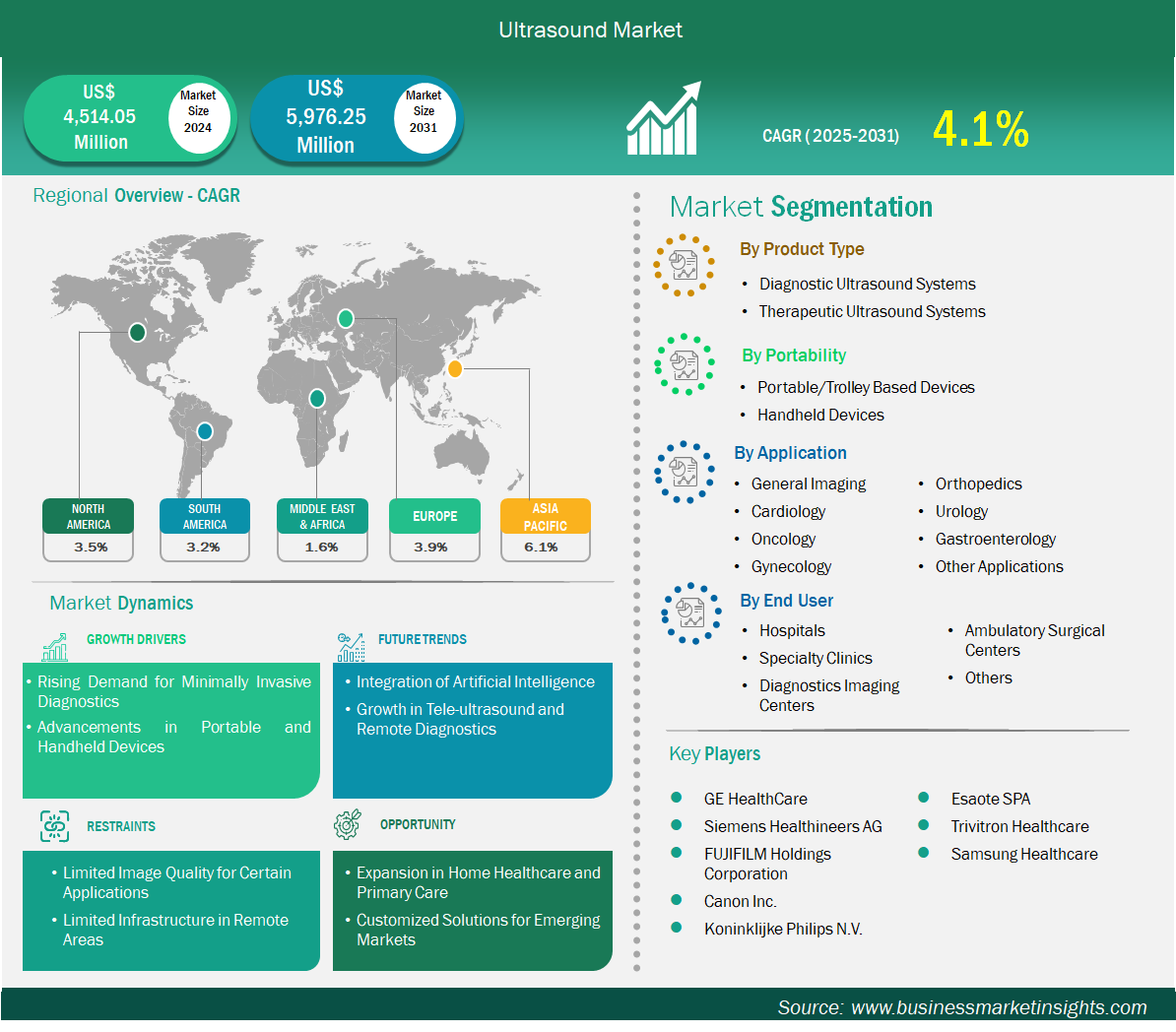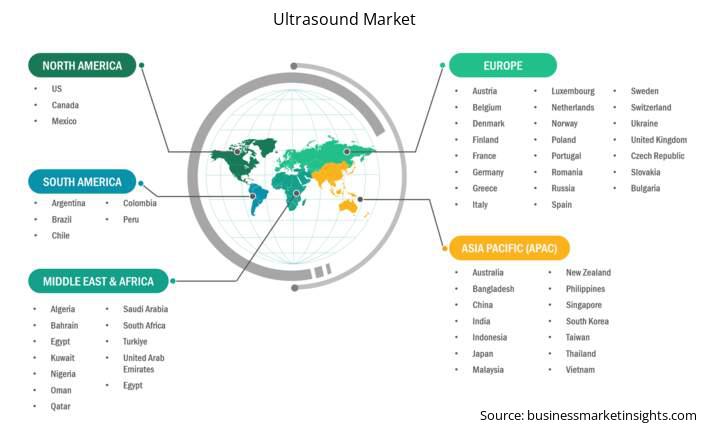The ultrasound market size is expected to reach US$ 5,976.25 million by 2031 from US$ 4,514.05 million in 2024. The market is estimated to record a CAGR of 4.1% from 2025 to 2031.
Executive Summary and Global Market Analysis:
The ultrasound imaging market is likely to grow due to the versatility, affordability, and expanded clinical applications. It is being used more frequently in emergency and critical care situations, and there is a growing demand for real-time, bedside diagnostics, all of which is increasing adoption worldwide. In addition, rising technological advancement such as wireless probe, Al-assisted imaging, and smartphone-compatible devices are making ultrasound a more widely available tool beyond the traditional hospital setting. It is radiation-free and can be used repeatedly in maternal care, pediatrics, and management of chronic disease. With new models of care and a growing focus on value-based care globally, there is increasing demand for portable and point-of-care ultrasound solutions.
In line with the adoption rate, the global ultrasound market stood at US$ 4,514.05 million in 2024 and is expected to reach US$ 5,976.25 million by 2031. There can be challenges associated with ultrasound specifically in regards to limitations of image quality for deeper tissues and the necessity for skilled operators in certain clinical scenarios and resource-limited settings.
Ultrasound Market Strategic Insights

Ultrasound Market Segmentation Analysis
Key segments that contributed to the derivation of the ultrasound market analysis are product type, portability, application, and end user.
Ultrasound Market Drivers and Opportunities:
Rising Demand for Minimally Invasive Diagnostics
The ultrasound market is growing due to an overall market trend in minimally invasive diagnostic procedures. Sonography is different from CT and X-ray imaging because it does not involve the use of ionizing radiation. This is important for frequently repeated exams, especially for vulnerable populations like pregnant women and children. Ultrasound also allows us to provide real-time imaging, which allows clinicians to complete guided interventions like biopsies, fluid drainage, or catheter placement, while minimizing injury to the patient. As health systems continue to move toward improved early diagnosis and trend toward outpatient settings rather than inpatient, the ultrasound technology continues to provide timely, low-cost, and non-invasive diagnostic imaging. The real-time imaging is used in various disciplines; obstetrics, cardiology, musculoskeletal, emergency care, etc. This is moving more things to the outpatient model, as there is a preference for less invasive and safer, faster, diagnostic techniques. This continues to show upwards trends globally for ultrasound more specifically and new demand for more readily available diagnostic imaging.
Advancements in Portable and Handheld Devices
Technological advancements have fundamentally changed the ultrasound industry, especially with the creation of handheld and portable devices. These portable systems provide portability and mobility that bulky machines cannot, which is what makes them suited for point-of-care environments like emergency rooms, ambulances, intensive care units, and even remote or rural locations. Today's portable ultrasounds are frequently linked to smartphones and tablets, with intuitive interfaces and cloud connectivity, offering real-time diagnostics and remote consultations. Small as they are, image quality and functionality have significantly improved, supporting high diagnostic accuracy. These developments not only are improving clinical workflows but also are extending ultrasound use among general practitioners, nurses, and paramedics. As healthcare systems worldwide move toward decentralization and mobile health solutions, the adoption of portable ultrasound devices is expected to grow rapidly, driving significant market expansion.
Ultrasound Market Size and Share Analysis
By product type, the ultrasound market is segmented into diagnostic ultrasound systems and therapeutic ultrasound systems. The diagnostic ultrasound systems segment dominated the market in 2024. Used widely for non-invasive, real-time imaging across all specialties. Their versatility, affordability, and routine use in general care make them the dominant ultrasound product type.
By portability, the ultrasound market is segmented into portable/trolley-based devices and handheld devices. The Portable/Trolley Based Devices segment dominated the market in 2024. The portable/trolley-based devices segment provide the ideal balance of mobility and imaging power. Common in hospitals and clinics for bedside, emergency, and routine exams—making them the most used format.
By application, the ultrasound market is segmented into general imaging, cardiology, oncology, gynecology, orthopedics, urology, gastroenterology, and other. The general imaging segment dominated the market in 2024. Covers the widest range of high-volume procedures including abdominal, thyroid, and vascular scans. Used in nearly all patient evaluations, driving consistent and dominant usage.
By end user, the market is segmented into hospitals, specialty clinics, diagnostics imaging centers, ambulatory surgical centers and others. The hospitals segment held the largest share of the market in 2024. Hospitals represent the leading end users in the ultrasound market due to their extensive infrastructure, skilled personnel, and ability to handle high patient volumes.
| Report Attribute | Details |
|---|---|
| Market size in 2024 | US$ 4,514.05 Million |
| Market Size by 2031 | US$ 5,976.25 Million |
| Global CAGR (2025 - 2031) | 4.1% |
| Historical Data | 2021-2023 |
| Forecast period | 2025-2031 |
| Segments Covered |
By Product Type
|
| Regions and Countries Covered | North America
|
| Market leaders and key company profiles |
|
Ultrasound Market Report Coverage and Deliverables
The "Ultrasound Market Size and Forecast (2021–2031)" report provides a detailed analysis of the market covering below areas:
Ultrasound Market Country and Regional Insights

The geographical scope of the ultrasound market report is divided into five regions: North America, Asia Pacific, Europe, Middle East & Africa, and South & Central America. The ultrasound market in Asia Pacific is expected to grow significantly during the forecast period.
The Asia Pacific ultrasound market is segmented into China, Japan, South Korea, India, Australia, New Zealand, Indonesia, Malaysia, Philippines, Singapore, Thailand, Vietnam, Taiwan, Bangladesh and Rest of Asia. The Asia Pacific region's ultrasound market is experiencing robust growth with growing healthcare awareness, enhanced government spending, and expanding diagnostic service access. Urbanization and a rising middle-class population are fuelling demand for cost-effective, non-invasive imaging, particularly in maternal care, cardiology, and general diagnostics. Handheld and portable ultrasounds are increasingly being utilized in rural and underserved areas through the global push to augment primary health care systems. In addition, point-of-care ultrasound is increasing in utilization across emergency and critical care departments. Local manufacture and more investments in Al-based imaging technologies will help to advance the sector even further. However, high cost, lack of skilled technicians, improper healthcare infrastructure across the region can hamper the market growth.
Ultrasound Market Research Report Guidance
Ultrasound Market News and Key Development:
The ultrasound market is evaluated by gathering qualitative and quantitative data post primary and secondary research, which includes important corporate publications, association data, and databases. A few of the key developments in the ultrasound market are:
Key Sources Referred:
The Ultrasound Market is valued at US$ 4,514.05 Million in 2024, it is projected to reach US$ 5,976.25 Million by 2031.
As per our report Ultrasound Market, the market size is valued at US$ 4,514.05 Million in 2024, projecting it to reach US$ 5,976.25 Million by 2031. This translates to a CAGR of approximately 4.1% during the forecast period.
The Ultrasound Market report typically cover these key segments-
The historic period, base year, and forecast period can vary slightly depending on the specific market research report. However, for the Ultrasound Market report:
The Ultrasound Market is populated by several key players, each contributing to its growth and innovation. Some of the major players include:
The Ultrasound Market report is valuable for diverse stakeholders, including:
Essentially, anyone involved in or considering involvement in the Ultrasound Market value chain can benefit from the information contained in a comprehensive market report.